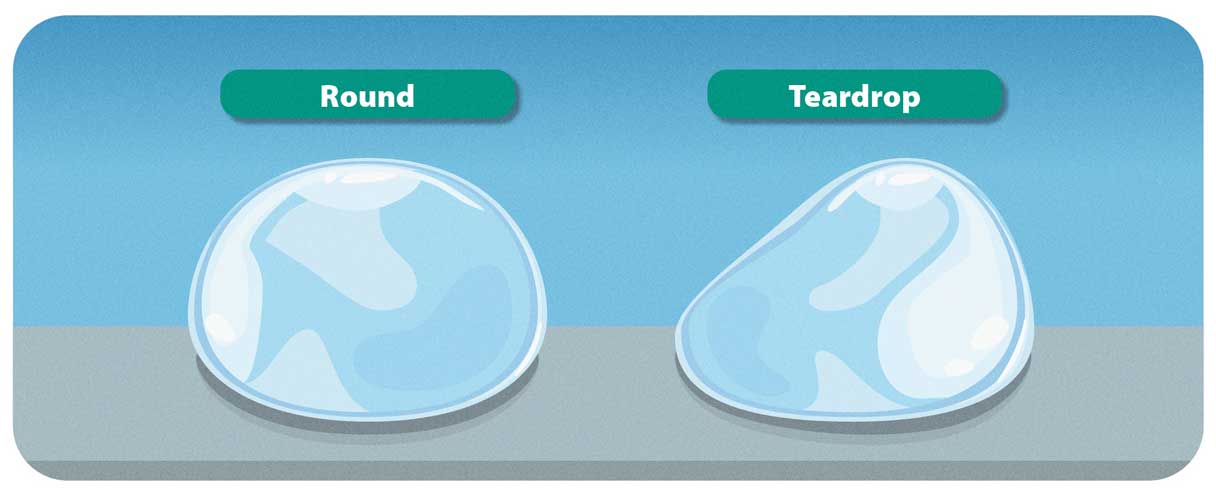Breast implants can enhance the shape, size and proportions of the breast and improve your self-image and confidence.1 Not surprisingly, breast augmentation (aka a boob job) is one of the most popular plastic surgery procedures in the United States.2
If you’re considering breast implants, it's important to know that choosing your new breast size is about more than just the size of the implant. The type, shape and projection matters, too.3
This handy breast implant shape and size guide provides information on the available options and other considerations to help you make an informed decision.
Types of Breast Implants
There are two types of breast implants: silicone implants and saline implants. Both types consist of a medical-grade silicone shell, but one is filled with silicone and the other with saline.4
Here's a quick look at both types and the variations of each that are available:5
Saline implants
-
Filled with saline (sterile water)
-
FDA-approved for people 18 years and older
-
Volume can be adjusted after surgery if needed6
-
Tend to have a uniform firmness and shape
Silicone implants
-
Filled with silicone gel
-
Approved for people 22 years and older
-
Tend to have a more "natural" feel
-
Form-stable silicone implants are more dense than other silicone implants and hold their shape when pressed or if the shell leaks.
Breast Implant Textures
Both silicone and saline implants are available in smooth and textured shells.
Smooth implants have a smooth surface and feel softer than textured implants. Their surface allows them to move naturally with the implant pocket. The downside is that rippling can sometimes be seen or felt under the skin over smooth implants.5
Textured breast implants have subtle texturing on the surface that allows scar tissue to stick to the implants so they’re less likely to move inside the breast pocket and change position. Textured implants are also less likely to cause capsular contracture, which is when the scar tissue that naturally forms around the implant becomes too tight. However, they are associated with a higher likelihood of breast implant-associated anaplastic large cell lymphoma (BIA-ALCL).5
Your surgeon should discuss the different breast implant types available, including any potential complications.5
Breast Implant Sizes
Size matters when it comes to breast implants, but it’s not the only factor to consider — other aspects of the implants affect how big and prominent the breasts will appear.
Breast implant volume
It’s natural to think of breast (and implant) size in terms of cup sizes, but plastic surgeons go by cubic centiliters (cc) to measure the volume of saline or silicone in a breast implant shell.7
Cup sizes aren’t a reliable means of measurement, and they vary among manufacturers and bra styles. Trying out different implant shapes and sizes during your consultation is the best way to understand which option will give you the look you want. But, for the sake of reference, here are some helpful points about implant volume:7
-
Breast implants can run from 80 cc to 800 cc.
-
The most common breast implant size is around 400 cc.
-
It takes approximately 200 cc to increase breasts one cup size — though again, a cup size varies between bra makers and designs.
The following chart shows the approximate breast implant volumes needed to achieve different cup sizes, starting from an A, B or C cup.7
| Desired cup size | Approximate breast implant volume |
|---|---|
|
A to B cup |
250 cc to 300 cc |
|
A to C cup |
300 cc to 350 cc |
|
A to D cup |
370 cc to 430 cc |
|
B to C cup |
250 cc to 300 cc |
|
B to D cup |
350 cc to 400 cc |
|
B to DD cup |
400 cc to 450 cc |
|
C to D cup |
300 cc to 350 cc |
|
C to DD cup |
370 cc to 450 cc |
|
C to E cup |
450 cc to 550 cc |
Breast implant profile
Just as important as the size of the implant is the profile, which is how far the breasts project outward from your chest.8
You have a few profile types to choose from. These are the options starting with the lowest projection to the highest:8
-
Low. Low-profile implants are relatively flat with a wide base, which provides a softer appearance to the breast.
-
Moderate. Moderate-profile implants also have a wide base but a higher projection than low-profile and usually provide the most natural results on most body types.
-
Moderate plus. Moderate-plus projection implants have a higher projection than moderate-profile but are narrower at the base and tend to be the most popular implant profile.
-
High. High-profile implants have a very narrow base width, which gives the breast a fuller and rounder appearance and prominent projection. They often need to be filled to capacity, which can make them very firm.
-
Ultra-high. Ultra-high-profile implants have the narrowest base with the most fullness and provide the most dramatic silhouette.
Breast implant diameter
Breast implant sizes don’t just vary by fullness and projection, but also by diameter. The size of the implant you and your surgeon choose will be based on the diameter of your natural breasts. One that is slightly narrower or approximately the same width as your breast is usually best.3
To get the right size, each of your breasts is measured in a straight line from your cleavage to the outer portion next to your arm. Most breasts are between 11 and 14 centimeters.3
Breast Implant Shapes

Breast implants are available in two shapes: round and teardrop.
-
Round implants. These have a consistent shape all over and provide a fuller appearance than teardrop implants. They’re available in varying profiles to provide more projection for those who want it. Their consistent shape makes them less likely to rotate out of place than shaped implants.5
-
Teardrop implants. Teardrop-shaped implants are narrower on top and gradually widen toward the base for more projection at the bottom, mimicking the shape of a natural breast. The shape requires a larger incision for placement than a round implant. If it rotates out of place, it could alter the appearance of the breast and require separate surgery to correct it.5
Other Factors to Consider When Choosing Implant Size and Shape
Along with the type and texture of the implants, there are other factors that you and your surgeon should take into consideration to determine the best size and shape of implants for you. These include:7
-
Your body frame. Your surgeon will take your body frame and proportions into consideration when helping you choose the best breast implant size and shape. This includes your height and weight, natural breast volume and shoulder width.
-
Cost. Breast augmentation costs* between $5,100 and $18,465, not including insurance and depending on the type of implants you choose, the procedure used and other factors. Surgeons’ fees can also vary depending on their location and credentials.9
-
Your goals. Be candid with your surgeon about your goals for surgery, whether it’s a minor or significant increase in breast size or to restore symmetry if one breast is smaller than the other. This way, they can help you choose the implants that will help you achieve the look you’re hoping for.
-
Your lifestyle. Your breast implant size shouldn’t interfere with your daily life or activities. Consider whether larger breasts might feel cumbersome to you during certain activities, such as exercise or playing sports.
A consultation with a board-certified plastic surgeon with proven experience in breast augmentation is the best place to start if you’re considering getting breast implants.4 This gives you the opportunity to learn about your options and find a provider you’re comfortable with.
Financing Breast Implants With the CareCredit Credit Card
Ready to revitalize your appearance and boost your confidence? The CareCredit credit card makes it easy to pay for breast implants and related expenses not covered by health insurance.** Use our Acceptance Locator to find a doctor or cosmetic surgeon near you that accepts CareCredit so you can stop dreaming and start living your best life. Continue your wellness journey by downloading the CareCredit Mobile App to manage your CareCredit account, find a provider on the go and easily access the Well U blog for more great articles, podcasts and videos.
In addition to cosmetic procedures, you can also use your CareCredit credit card for dentistry, pet care, vision, hearing, health systems, dermatology, pharmacy purchases, spa treatments and so much more within the CareCredit network. How will you invest in your health and wellness next?
Author Bio
Adrienne Santos-Longhurst is a writer who has been covering health and lifestyle for almost two decades. Her work has appeared in Healthline, Insider, Medical News Today and more.








